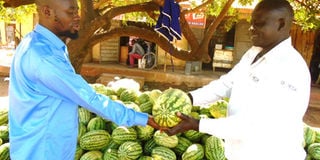Okello quit rice farming to grow watermelons

Okello sells the surplus fruits at the local market in Kayunga District. Most of his fruits are bought at farm gate. Photo by Fred Muzaale
What you need to know:
Yield in watermelons depends highly on pollination by bees. Therefore, it is recommended to place a beehive per each acre. This also means that use of pesticides should be minimised to avoid killing pollinating insects, writes Fred Muzaale
A middle-aged man braves the mid- morning heat to sell watermelons in Kayunga Town, Kayunga District.
Because of the current heat in the area, Charles Okello, a watermelon farmer and seller, says the fruits are on high demand.
Previously, though, Okello says he used to be a rice farmer. He however, switched to watermelon growing in 2016 after he realised that rice growing was a tough job yet not well-paying.
“I used to spend almost the whole day for about two months in the garden scaring away birds from eating the rice. Besides this, planting rice in the water was not a simple job as my feet would usually get several wounds,” Okello says.
After all this tough work, Okello would earn peanuts from his produce.
Turning point
In 2016, Okello was advised by a friend who, was growing watermelon to switch to the crop. He took him through the agronomy practices of watermelons and he decided to give it a try.
Since that time, Okello says, he has never regretted the decision given the high returns he gets from the enterprise.
How to plant watermelons
Okello says that watermelons do well in light, sandy fertile and well-drained soils yet retain moisture.
He grows Red Crimson sweet watermelon variety. This variety is highly marketable because of its red flesh and high sugar content.
He says after preparing the soil, dig holes of 1-2 inches deep. However, before planting the seeds it is advisable to add completely decomposed organic manure in the holes.
This, he says, augments the soil fertility since watermelons need a lot of fertility to grow well.
Then plant a seed in each hole. The holes should be four feet apart. After three to four days, the watermelon seeds begin to germinate.
A week after germinating, Okello says the watermelon seedlings should be sprayed with pesticides such as Dudu Cyper to kill the insects that eat the leaves and stems.
Also, they should be sprayed with Vegemax and Super glow, both foliar fertilisers to boost their growth.
“Applying fertiliser during the initial stages of planting helps to boost nutrients and make the fruits grow bigger,” he says.
Okello says he also mulches his garden when the watermelons are about three weeks old. Plant leaves or maize residues can be used to mulch. Mulching not only suppresses weeds but also preserves moistures in the soil.
Watermelon fruits are ready for harvesting after between two and a half months to three months, depending on the variety and soil fertility.
Market
He sells his fruits to traders from Kampala, Jinja, Kenya and South Sudan plus individual consumers.
Challenges
OKello’s biggest challenge is the high prices of pesticides and fertilisers which he says reduce his profits.
Also, the fluctuating prices for the fruit, makes it hard for him to effectively plan as the prices go down during the rainy season.
Nevertheless, Okello says he has no regrets quitting rice growing to plant watermelons and adds that he plans to expand to two acres.
Harvests
Currently, Okello says, he has one acre of watermelon and every week he harvest about 200 fruits. He says after harvesting he sells some to traders at farm-gate price of Shs2,500 for a big one and Shs1,500 for a medium sized one.
The traders buy the fruits from the garden so he doesnt incur transport costs.
However, Okello says, he earns more when he takes the melons to Kayunga market and sells them himself.
This, is because he sells to the consumers. In the market, he currently sells a big melon at Shs4,000 and a medium sized one at Shs3,000.
He says every week he earns about Shs800,000 from his venture. He, however, says he gets more money during long dry spells when the fruits are on high demand.




